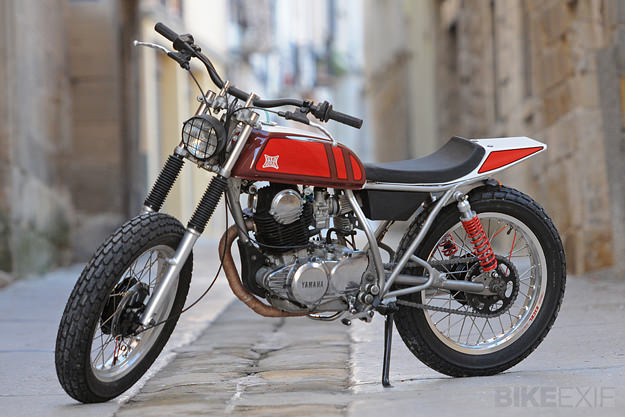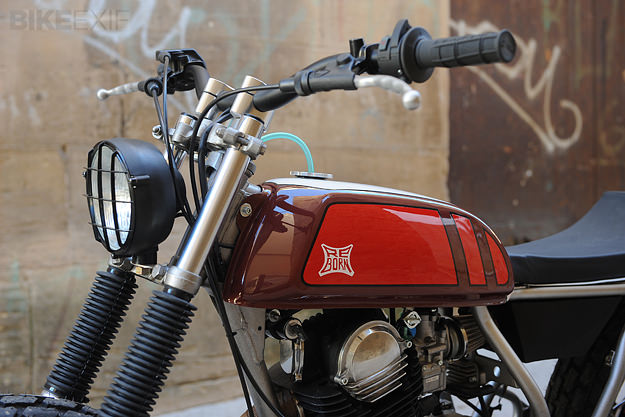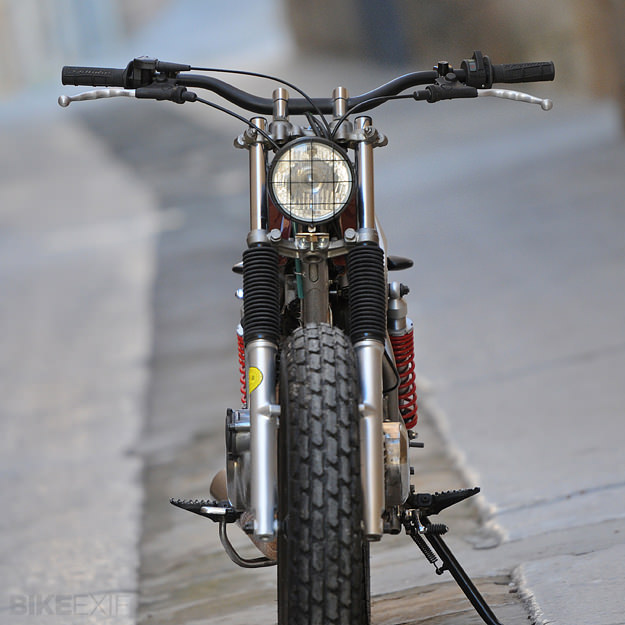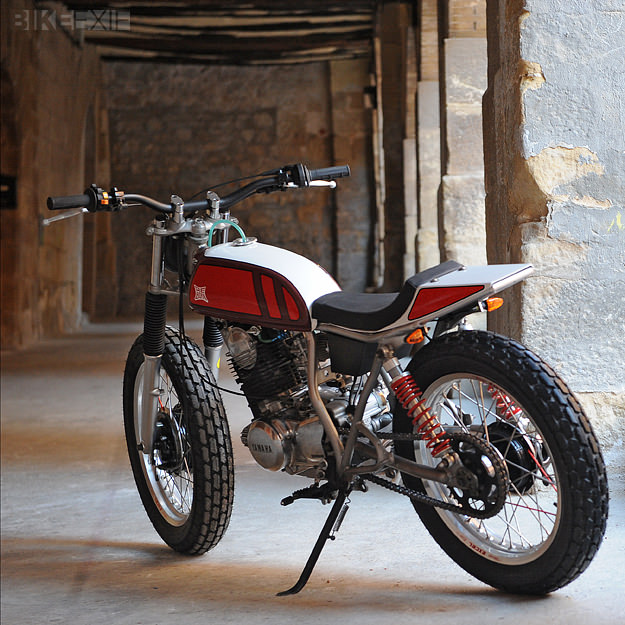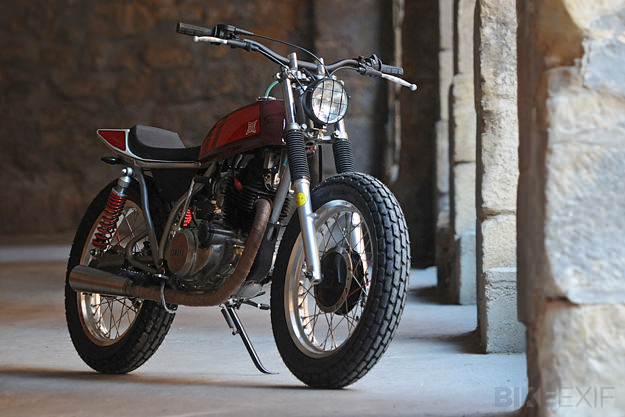Documentary shot on super 16mm relating the hopes and desires of those who go for a motorcycle road trip.
Tuesday, January 29, 2013
Long live the kings - Blitz Motorcycles
Documentary shot on super 16mm relating the hopes and desires of those who go for a motorcycle road trip.
Monday, January 28, 2013
Matt Machine
This short movie by Matthew Harrington, owner of Matt Machine is just simply amazing. If you want to know more about this Australian bike builder, you can read an interview here.
Friday, January 25, 2013
HONDA CB450 CAFE RACER
Eric Meglasson lives in Bend, Oregon, and his motorcycling journey has had its fair share of twists and turns. “Over the years, my bikes kept getting faster and faster,” says Eric. “But I started longing for a slower, more fun, naked bike to ride on the street at more reasonable speeds.” Although Eric owned a Monster, he’d been collecting images of café racers for years. “I loved the pure, shiny café racers, but also loved the fat tired, matte-finish bikes. I didn’t even know the term Brat existed at that point.”
While recovering from knee surgery after a supermoto race accident, Eric sold a dirt bike to free up some dollars—and started researching his next purchase. “I probably looked at every motorcycle on Bike EXIF. After several weeks of Craigslist and eBay shopping, I stumbled upon ‘Rusty’. I was blown away. The second I saw this Honda cafe racer, I knew it was exactly what I wanted.”
The CB450 was built by Jared Johnson of Holiday Customs, a one-man builder in Portland, Oregon, who shares a shop space with two other builders. The engine has been revitalized with an overbore kit from Superior Sleeve & Machine in Milwaukie, OR. The airbox has been removed, and cone filters fitted. The custom straight pipes are raw steel (“requires lots of WD-40 to keep the rust at bay”) with custom baffle inserts “to keep my neighbors happy”.
To accentuate the clean look, the flat bars have a sanded raw steel finish and house just levers and the throttle—no instruments at all. “The local coppers have looked at it, but don’t seem to mind, as long as I hand signal,” says Eric.
The suspension has been lowered 1½” all around with shorter rear shocks and lowered triple clamps; the wheels are 18“ front and rear, shod with 18 x 4.5” Coker tires.
The frame has been bobbed at the back, with tabs shaved off, and fitted with a custom seat pan. Aside from the paintwork, the finish on the Honda is mostly wire brush on the shinier metalwork, with matte black everywhere else.
After buying his Honda cafe racer, Eric tidied the bike up still further with a complete re-wire, and now does all his own maintenance. And he’s been inspired to get his hands increasingly dirty. “I’ve started my own project bike, a 1982 Virago inspired by Classified Moto—and I’m also helping a couple of friends with their own builds.”
Great to see another home builder in the making—especially one with such good taste.
Images by Alan Brandt Photography.
Russell Mitchell
Bike builder Russell Mitchell, owner of Exile Cycles and known by most people from Discovery Channel's programme Biker Build-Off, shares his passion for bikes with the rest of the world. When I saw his first bike for the build-off, I was immediately sold . The minimalistic style with clean handlebars is something you won't see every day. If you want to get an Exile cycle or if you want to clean up your own bike by using one of the kits they sell, I suggest you visit their website.
Wednesday, January 23, 2013
Analog CB350
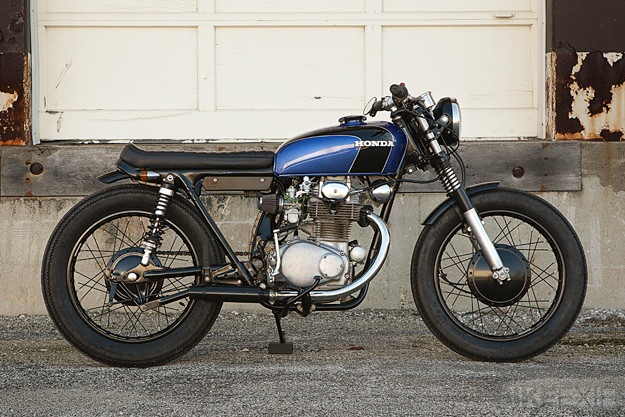
This elegant and deceptively simple Honda CB350 was built for Mike Hranica of The Devil Wears Prada He chose Tony Prust of Analog Motorcycles to deliver. “Mike wanted a build based on a smaller displacement Honda,” says Prust. “I had a CB350 in the donor bike storage bin; Mike had a fairly specific idea of the stance and overall appearance.”
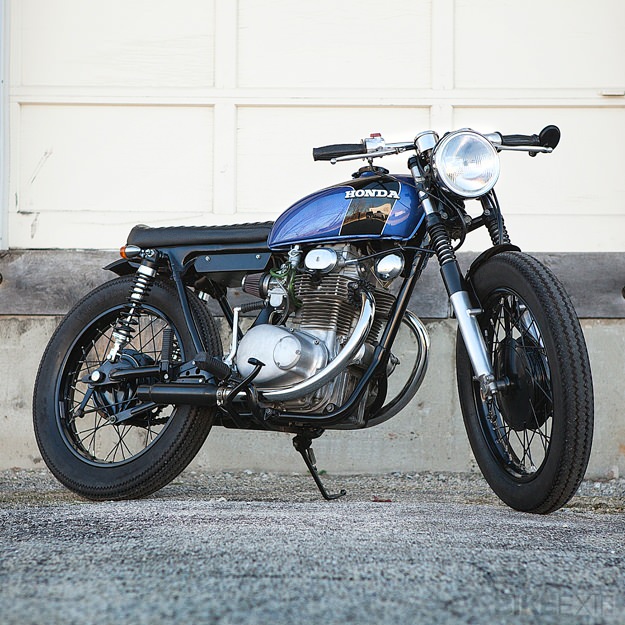
Hranica wanted a low 70s-style moto to cruise around his home in Chicago, but Prust had reservations. “I frequent Chicago, and the potholes there make a low bike dangerous. So I decide to leave the front suspension height alone, and lower the rear just a little with Gazi shocks—to keep it from bottoming out and give it better dampening. Adding tall sidewall Firestones filled in the look well, and gives the CB350 a low appearance without the low ride.”
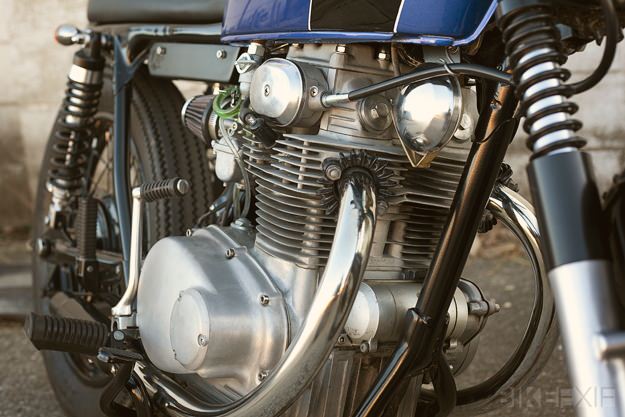
Jason Koschnitzke at Motto Moto rebuilt the engine to stock specs. It’s now fitted with Mikuni VM30 carbs and K&N pod filters; the exhaust headers are stock but hooked up to shorty mufflers. The sparks come from Dyna mini coils and an Earth X lithium iron phosphate battery.
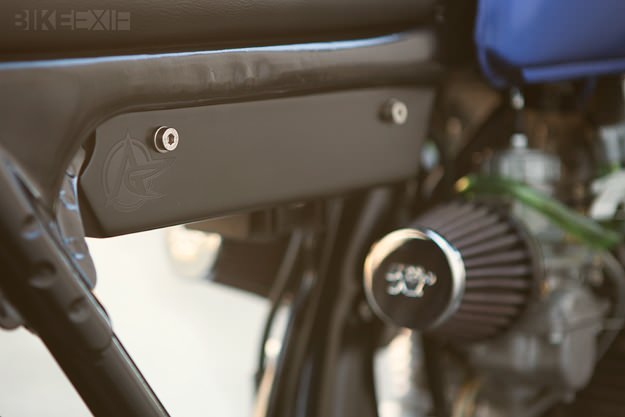
The subframe has been modified to suit the new seat style,
and the paint, although custom, could be straight from a 70s bike brochure. New
bars and indicators complete the low-key but classy look.
I’m sold. If you are too, check out Analog Motorcycles via their website and Facebook page.
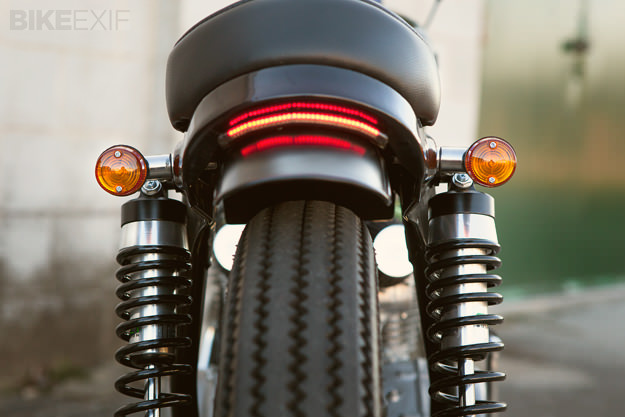
Thursday, January 17, 2013
1938 DKW NZ350
This bike is from the Russian guy named Vasiliy Arkhipov and as you might have guessed
from looking at this bike, he has some skills up his sleeve. After working in
the automotive industry for over 7 years, Vasiliy who is only 30 years old, now
works in the aerospace industry as an industrial designer, specializing in
carbon fibre. So he decided to use all of his talents to create a bike that is
out of this world.
To fully appreciate the build
and the bike, I have to give you a really quick history lesson on Russian
motorcycle manufacturing. It might sound like something out of a Russian spy
movie, but this bikes history started back in 1945 when drawings and equipment were
taken back to the USSR from the German motorcycle manufacturing plant DKW. They
made an almost exact copy of the legendary DKW NZ350 at the Russian plant
called Izhevsk, and named it the IZH350, which became one of the first
production motorcycle in Russia.
 Here's Vasiliy to tell us more
about this unique project. "A good friend of mine got one German made
1938 DKW in very poor condition and he also had some parts from the
IZH. In Russia, the bike is valuable to collectors so we decided
to reincarnate it. We had a spare engine from Yamaha Diversion, which
we decided to use. Wheels and brakes were taken from a Yamaha R6. Then we had
to redesign the frame, making the motor fit inside it. After that we redrew the
tank, making the diffusers for carbs that hides the filters. Rear wing,
graying and bracket for registration number all made of carbon fiber. The
electrical system and battery are located in a leather box under the
seat."
Here's Vasiliy to tell us more
about this unique project. "A good friend of mine got one German made
1938 DKW in very poor condition and he also had some parts from the
IZH. In Russia, the bike is valuable to collectors so we decided
to reincarnate it. We had a spare engine from Yamaha Diversion, which
we decided to use. Wheels and brakes were taken from a Yamaha R6. Then we had
to redesign the frame, making the motor fit inside it. After that we redrew the
tank, making the diffusers for carbs that hides the filters. Rear wing,
graying and bracket for registration number all made of carbon fiber. The
electrical system and battery are located in a leather box under the
seat."
This ambitious project took
Vasiliy around 10 months to complete. "At the end, I've got a very
comfortable bike for every day use" he says. But it's a lot more
than that. Vasiliy has built a stunning bike that is part vintage, part modern,
part historic, part futuristic, part innovative and part genius.
Wednesday, January 16, 2013
Monday, January 14, 2013
Reborn Motors
A new shop opened up in Barcelona called Reborn Motors. Their motto, 'a new life for your bike' suits their style perfectly as this shop works closely with their customers to customize your old bike. This clean Yamaha SR250 street tracker is the first one to roll out of the workshop. Being light and maneuverable, it's perfect for both the small city streets and the gravel tracks further afield. Jim Palau-Ribes, a European car designer who also runs Pursang runs the workshop, with bike mechanic Hector Zayas at his side.
Why a SR250? 'It's a common bike here in Barcalone,' says Palau-Ribes, 'so we thought it would be a good starting point: to take an ordinary old bike and turn it into something special.' And it sure is special. The modifications are well thought-out and functional, with a 34mm Dell'Orto carburetor and short-throw throttle adding to the experience when riding this beauty.
The handlebars are from a Sherco 450i enduro bike, and the triple clamps and footrests are from a Honda CRF. Dunlop K180 tires ride on Excel Takasago 2.50 x 18" rims, and Betor shocks smooth out the ride. The SR250 also now has a kickstarter and the tank is from a vintage Derbi Tricampeona moped.
Why a SR250? 'It's a common bike here in Barcalone,' says Palau-Ribes, 'so we thought it would be a good starting point: to take an ordinary old bike and turn it into something special.' And it sure is special. The modifications are well thought-out and functional, with a 34mm Dell'Orto carburetor and short-throw throttle adding to the experience when riding this beauty.
The handlebars are from a Sherco 450i enduro bike, and the triple clamps and footrests are from a Honda CRF. Dunlop K180 tires ride on Excel Takasago 2.50 x 18" rims, and Betor shocks smooth out the ride. The SR250 also now has a kickstarter and the tank is from a vintage Derbi Tricampeona moped.
Thursday, January 10, 2013
1982 CB450 by JMR Customs
Decisions, decisions.
What colour should I make the tank? Or should the tank be bare metal? How do
you coat bare metal so it doesn't rust? What tires should I choose? Should I
choose the same front and back tires or should they be different? How low
should it be? If I lower it, will it change the handling? What rims should I
use? Should I keep the standard headlight? Do I use pipewrap or not? Do I need
fenders? Will the bike attract the cops? Should it be clean or ratty? Will it
look weird or will it look cool? Customising a bike involves so many questions.
All of them seem insurmountable, yet you somehow know that what makes a great
bike is just the final sum of all these tiny little decisions. Hold back on
them and you'll get a bike that blends into the background like a turd at a
chocolate festival. Go overboard and you'll spend your weekends ignoring the
chuckles and the rolled eyeballs as you arrive at your local hang. But get it right...
“Hello, my name is Josh Mott. I’m 22 years old
and owner of JMR Customs in Boise, Idaho. I’m a 3rd
generation mechanic, racer, and bike builder. I’ve been racing for 10 years in
many disciplines such as: flat track, arenacross, endurocross, and desert
racing. Currently I’ve been racing the National Hare & Hound series.
From a very early age
I’ve helped my dad (Randy Mott) repair, service, and build custom motorcycles.
Notable achievements include building a 1200 Sportster that ran an 11 second
quarter mile and restoring a 1964 Greeves Challenger. I find a great deal of
influence from custom styles: café, street trackers, bobbers, and basically any
one-off custom motorcycle.”
“This 1982 CB 450
Honda Nighthawk was originally picked up to part out and sell on eBay. It was
roached beyond belief. It had bent forks, a wiring harness that was stripped,
and a missing fuel tank. Out of curiosity I thought I’d check the compression
and spark to see if it had some sort of working order. It had 175 psi in both
cylinders and had spark. I decided to clean the carbs and it fired right up.
I had an idea that I wanted to put a motocross front end, lowered down, on
a café style build. I had a 2006 YZ250 Yamaha front end sitting at the shop
waiting for a project at the time, it was perfect. I ended up lowering the
forks 7 inches to get the right height. As I finished this portion of the
build, I then had the idea to mount a mono shock. I used a 2005 TT-R 250 Yamaha
shock because it fit really well in the small space I had to work with.”
“The fabrication work
included many modifications. I cut the whole back half of the frame clean
off to begin the custom portion. I had the older Champion flat track frames in
mind where the frame was exposed right below the rear fender. I wanted the seat
portion to sit within the frame.
The overall bike
length looked shorter than I preferred so I cut the frame by the headset and
raked it from the stock 28 degrees to a custom 34 degrees. I center
mounted the fuel tank which involved cutting the top of the tank out. While I
had the top of the tank out, I mounted a sleek, flush mount gas cap. Custom exhaust
pipes were made to fit some after market Ducati mufflers I had, making the bike
sound like an older Triumph. The wiring harness was custom made before I installed the motor. I have a
key switch flush mounted on the right side of the frame and a start button on
the left. There’s a little switch dashboard mounted under the coil and tank.
There’s a high/low beam and a switch that turns on all the lights. I made a box
that’s mounted underneath the motor - it holds the battery, starter solenoid,
fuse box, and regulator rectifier.
”I pulled the motor
all the way down to replace the cam chain, rings and gaskets. While I was in
there I cleaned up the intake and exhaust ports in the head. A Magura
hydraulic clutch for a KX 450 was installed to replace the stock
component. For a speedometer, I used a Trail Tech Vapor and made a mount
that was clean to hide all the wires.
I’m very stoked on how this bike came together. It’s very unique in the
sense that there’s really no name for what type of build it is. It has elements
of café, motocross, and street tracker all in rolled into one. Thanks for
looking.”
Monday, January 7, 2013
Lucky 13 "Let's Ride" Hoodie Short Film
Not to promote the clothing of Lucky 13, but this is one great promo for a hoodie!
Saturday, January 5, 2013
Dime City Cycles
In a few short years Dime City Cycles has earned a loyal following as one of the many contributors to the revival of vintage bikes. In 2012 a team of students from Full Sail University, that were interested in vintage motorcycles, Cafe Racers in specific, approached Jason and Herm and asked if they could do their final project on the Dime City Cycles brand. After roughly three days of shooting and lots of time in the editing room they came up with this final piece.
"In our opinion, it's perfect, it tells our story giving those who already know us a little more intimate view of the interiour while at the same time giving those who do not yet know us the opportunity to introduce ourselves." - Dime City Cycles
Friday, January 4, 2013
The Motomethod Story
It's essentially about a motorcycle repair shop in Vancouver called Motomethod. They call themselves a 'community motorcycle repair shop', which means you can rent a bay and work on your bike, use their tools and even get help and advice from the mechanics and eachother. They charge around $100 a year for a membership, which seems pretty reasonable when you think a mechanic can charge that per hour to fix your bike. If you don't want to do it yourself, they're also a full blown motorcycle repair shop, and will work on pretty much any kind of motorcycle. Their idea seems to be paying off and has sparked a lot of interest in the local Vancouver community. The Motomethod clientele couldn't be more diverse, ranging from 16-year-olds to seniors, including some veterans and even some grandmothers. With space in big cities costing so much coin these days, we think this could work in many places. What do you think, would it work in your home town?
Thursday, January 3, 2013
BMW R80 "HUMMEL" by Rodney Aguiar
Rodney Aguiar, who has worked with Roland Sands before, has gone his own way a few years back. He makes up for his lack of publicity by creating awesome bikes, like this BMW R80, which he turned into a nice bike with minimalistic features and a hint of bobber. The seat is directly positioned on top of the monoshock and the boxer engine is complimented
with small pipes at the side. The conventional front shocks and the spoked wheels give it a more oldskool look and the yellow of the tank really brings the bike to life.
Rodney hasn't build a lot of bikes on his own except for a few other BMW's and a Mazda Rotary motorcycle, but from the looks of this one, I sure as hell hope he will in the future.
Wednesday, January 2, 2013
LOUIS75 JUBILÄUMSBIKE DUCATI
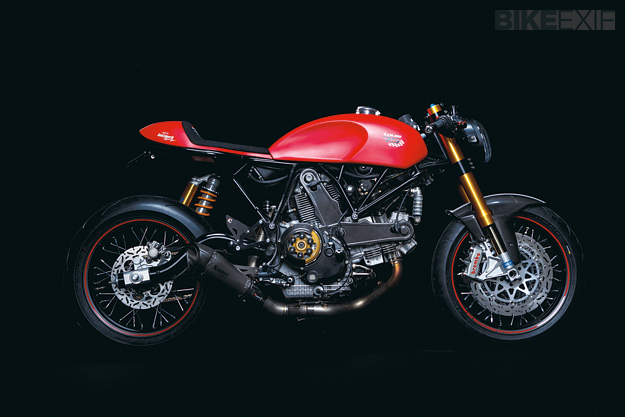
If you live in mainland Europe and ride a motorcycle, you’ve probably bought parts or accessories from a company called Louis. The Hamburg-based company is Europe’s largest moto retailer, and it’s just celebrated its 75th anniversary.
To mark the occasion, Louis commissioned Marcus Walz to build a custom bike—and asked for ‘a machine that combines tradition and the future.’ It was also a collaborative project with Louis’ customers: In five stages, votes were taken on Facebook regarding the basic concept, the wheels, handlebar, instruments and the finish.
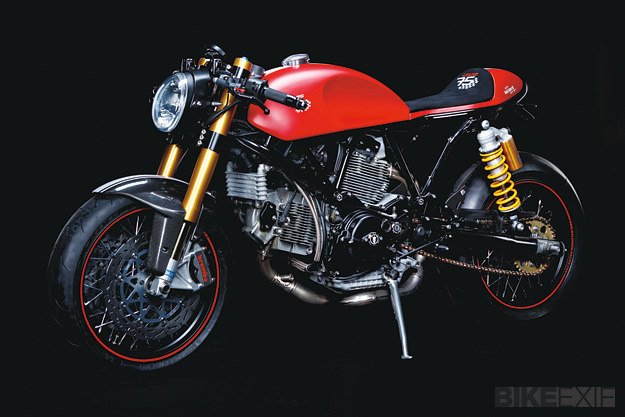
A Ducati Sport 1000 was chosen as the starting point. Walz rejigged the sheet metal to create a slim and wiry look: The tank, seat unit and rear bodywork were beaten by hand out of aluminum, and the rear frame was redesigned. Even the housing of the fuel pump is custom-built, also machined from aluminum and hidden from view by integrating it into the tank. An 800-gram lithium-ion battery is now concealed underneath the seat hump.
An Öhlins fork (from a Ducati 999R) is used at the front, and a custom-built height-adjustable suspension is used at the rear. The triple tree is made from billet aluminium: it weighs around 1.5 kg less than the original, and is three times as stable. The braking system is state-of-the-art, too: Brembo monoblocks together with Lucas ‘Wave’ discs.
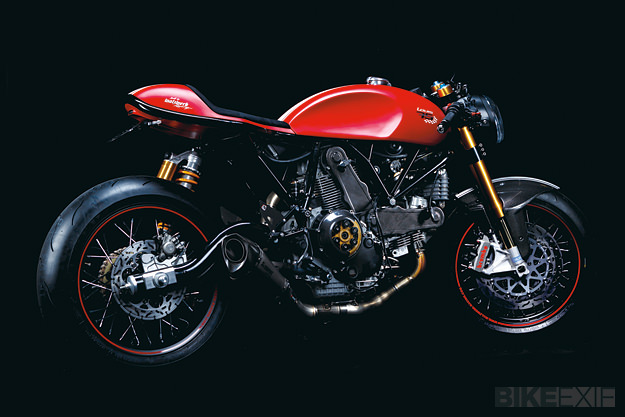
The controls are from LSL—from the bars and grips to the clutch and brake levers. Brake fluid reservoirs now sit on their own specially developed mounts, tightly and inconspicuously up against the triple tree. The V-Rod-style headlight (from Louis’ own range) adds to the compact feel of the front end. Walz foot controls, machined from aluminium, are adjustable in all directions. The wheels have Akront flat shoulder rims, and are shod with Metzeler Racetec K3 tires.
The inner workings of the Sport 1000 engine are untouched, with the exception of a light Ergal clutch basket and an SBK clutch. But engine output is up by eight horsepower, thanks to the titanium exhaust system developed by Akrapovic. And to give the engine a tidier appearance, Walz replaced the original oil lines with those from a Ducati Hypermotard—which do not run over the belt cover.
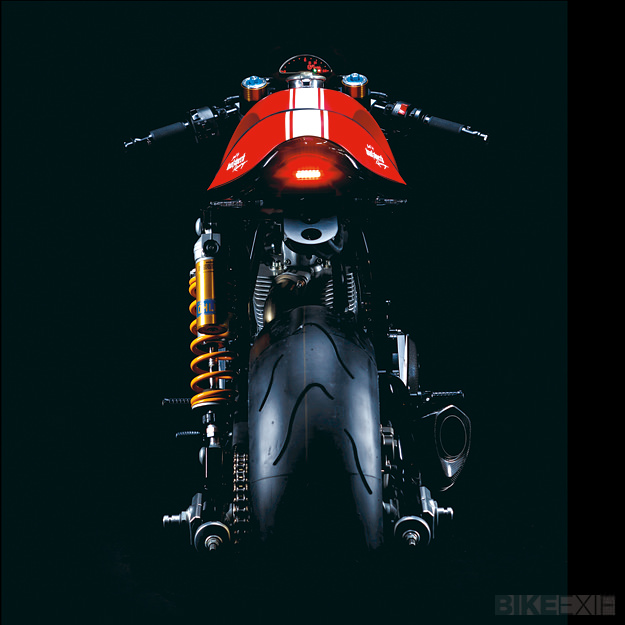
With the help of further mods such as an ultra-light wiring harness, the Ducati lost almost 20 kg in weight in the course of the rebuild. The finish is a special paint from the Ducati factory called “Anniversario Rosso,” used exclusively for anniversary and presentation models. It’s covered by a matt clear varnish that Walz describes as a secret mixture—smooth and low-maintenance like a gloss varnish, but with a subtle degree of matting.
The Jubiläumsbike will soon go on tour around Louis’ stores, and then it’ll be auctioned off with the proceeds donated to a good cause. Any bidders?
If you live in Europe, check out Louis’ online store here. And see more of Marcus Walz’ work on the Walz Hardcore Cycles site.
Subscribe to:
Posts (Atom)










